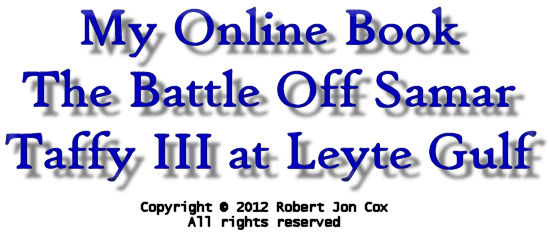
COMMENTS ARE ENABLED ON THE BOTTOM OF THE PAGE
Chapter 3
THE IMPERIAL JAPANESE
COMBINED FLEET
Four Japanese surface forces participated in SHŌ-GO, including every type of ship in their inventory. Three surface battleship-cruiser-destroyer forces would drive the Americans from the Leyte beachhead. The fourth force, consisting of aircraft carriers and two old hybrid carrier-battleships, would be used as a decoy to draw ADM Halsey’s Third Fleet northward, away from Leyte. During this stage of the war, due to fuel shortages, the majority of these warships were stationed at two widely dispersed locations. Located in the Japanese homeland at Kure Naval Base in the Inland Sea were the Mobile Fleet’s remaining aircraft carriers. Far to the south at Lingga Roads, near Singapore, were the major surface combatants.
|
The Northern Force was led by VADM Jisaburō Ozawa. He was considered the most talented Japanese Naval Officer remaining in the fleet. Originally, he was scheduled to attack from the north with Japan's remaining carrier forces. After the "Great Marianas Turkey Shoot" in June 1944, the Mobil Fleet’s total carrier aircraft strength was depleted to just over one hundred aircraft. Thus Japan had large fleet carriers remaining in her fleet, she just didn't have the aircraft or trained pilots to man them. It was then decided the force VADM Ozawa would take to Leyte would be used as a decoy to draw the American Third Fleet north. The decoy force consisted of: See: I.J.N. Warship Pronunciation (opens in new window)
To make his decoy force a more tempting target, three light carriers, ZUIHŌ (CAPT K. Sigiura), CHITOSE (CAPT Y. Kishi), and CHIYODA (CAPT E. Zyo) were included:
|
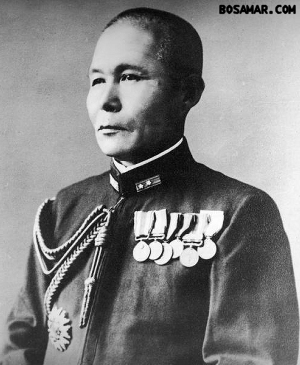 |
|||||||||||||
|
National Archives Photograph Vice Admiral Jisaburō Ozawa, IJN |
||||||||||||||
|
||||||||||||||
Escorting the carriers and battleships were the light cruisers ŌYODO, TAMA, and ISUZU. All three ships were capable of speeds up to 36 knots.
- Completed at Kure Dock Yard on April 28, 1943, ŌYODO was the largest and most capable of the three. She displaced nearly 11,500 tons fully loaded and carried an impressive main armament of six 6-inch, 60 caliber guns.
- ISUZU was half ŌYODO's size at 5,570 tons and was completed in 1923. After completing modification in 1933, she was finally rearmed as an anti-aircraft cruiser and flagship for anti-submarine groups in 1944.
- The eldest of the lot was TAMA. Completed in 1921, by July 1944 she was armed with five 5-inch, 50 caliber guns, two 5-inch AA guns, forty-four 45mm AA guns, and six 13mm machine guns.
The screening ships of the Northern Force consisted of six AKIZUJI Class 3,700 ton destroyers.
- AKIZUKI, SUZUTSUKI, HATSUTSUKI, WAKATSUKI, SHIMOTSUKI, and FUYUTSUKI were all built from 1940 onward. They were highly impressive ships boasting eight 3.9-inch, 65 caliber DP guns, four 25mm AA guns, 72 depth charges, and four 24-inch torpedo tubes. Originally planned as AA cruisers they were completed as destroyers with torpedo armament.
Four lighter warships of the MATSU Class completed the decoy force.
- KUWA, MAKI, KIRI, and SUGI were all completed within one month of each other in July-August 1944. Built as destroyer escorts they were equipped with Type 31 radar, three 5-inch, 40 caliber AA guns, twenty-four 25mm AA guns, 36 depth charges, and four 24-inch torpedo tubes.
The Northern Force, an impressive array of Japan's few remaining warships, would be the sacrificial lamb, laid on a plate for the Americans to consume. In order for SHŌ-GO to work, this force would have to draw ADM Halsey’s Third Fleet north, away from the Leyte invasion beach. The Japanese striking forces would then have a chance to rush in behind Third Fleet and disrupt the invasion. If VADM Ozawa’s force could achieve this goal his mission would be considered successful.
The strike on the American Leyte invasion force would come from the three remaining forces of the Japanese Combined Fleet. The most powerful group, the formidable First Strike Force "A" and "B", was comprised of thirty-two front-line warships. From their training location near Singapore these two groups would transit together to Leyte Gulf via the Sibuyan Sea and San Bernardino Strait. This route was the long way around and would take a considerable amount of time and consume a large amount of precious fuel oil. In addition, they would have to rely upon friendly air cover if their sortie was to be successful. Upon reaching the Philippine Sea, First Strike Force was to sweep down the east coast of Samar from the north and attack the invasion beach and shipping. Any American warships encountered along the way were to be destroyed.
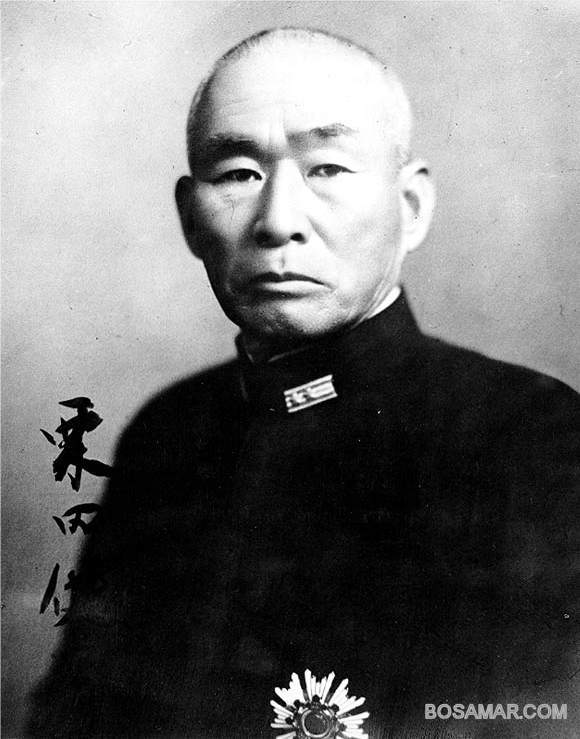
National Archives Photograph
"Opponent at Samar"
Vice Admiral Takeo Kurita, IJN
Commander First Strike Force "A" and "B"
Later designated as "Centre Force"
Admiral Toyoda, Commander of the Combined Fleet, placed his trust in seasoned warrior VADM Takeo Kurita to command First Strike Force. Under his experienced guidance, First Strike Force was to lead the Japanese Navy back on the road to victory. Late in the war, he was second in ability only to VADM Ozawa as a tactician. He had under his command five battleships in two divisions:
|
|
|||||||||||
|
||||||||||||
Though the Americans held the advantage in the total number of ships during the Battle of Leyte Gulf, the Japanese advantage was in their well-seasoned group of heavy cruisers. Cruiser Divisions (CRUDIV) Five and Seven, all veterans of the Pacific war, consisted of ten front-line warships. They constituted the fastest striking power of First Strike Force; each of these magnificent ships weighing in at 13,000 to nearly 15,000 tons. Coupled with their capable speeds well in excess of 30 knots, their main armament of eight to ten 203mm, 8-inch guns had destroyed many American warships through the Pacific war:
- NACHI Class heavy cruisers MYŌKŌ and HAGURO displaced 14,980 tons, both being built between 1924 and 1929. Modernized from 1939 to 1941 they carried ten 8-inch, 50 caliber guns, eight, 127mm (5-inch), 40 caliber DP guns, AA guns, torpedoes, and 3 aircraft.
- ATAGO Class heavy cruisers TAKAO, ATAGO, MAYA, and CHŌKAI were the backbone of the fleet. They were a modified MYOKO design, completed in 1932 and modernized in 1938/1939/1941. Originally displacing 12,986 tons, after modernization they weighed 15,781 tons fully loaded. Each ship carried ten 8-inch, 203mm, 50 caliber guns placed in five turrets in a three-forward low-high-low, two-aft, high-low configuration. This class was known for its impressive, almost battleship-like, large bridge structure.
- The MOGAMI Class heavy cruisers SUZUYA and KUMANO were the last two ships built in their class, both completed on October 31, 1937. Weighing in at 13,887 tons they were capable of sustained cruising at 35 knots. Originally armed with only torpedo tubes, in 1939/1940 they were rearmed as heavy cruisers with ten 8-inch, 203mm, 50 caliber guns, significantly increasing their firepower.
- TONE Class cruisers TONE and CHIKUMA were designed originally as MOGAMI Class light cruisers. Each had eight 8-inch, 203mm, 50 caliber guns in four turrets forward in a low, high, low, low configuration. Aft, they were able to accommodate five aircraft, as they were designated as float plane-carriers, intended to operate with carrier task forces, providing long-range air scouting.
Destroyer Squadron’s (DESRON) Two and Ten, each led by one light cruiser, boasted 15 capable destroyers, all armed with the dreaded long-lance torpedo.
- AGANO Class light cruisers NOSHIRO and YAHAGI were both completed in 1943 and were armed with six 6-inch, 50 caliber guns. Secondary armament consisted of AA batteries, torpedo tubes, and two float planes.
- Destroyer Squadron Ten's five KAGERŌ Class destroyers URAKAZE, ISOKAZE, YUKIKAZE, HAMAKAZE, were all completed in 1940, except NOWAKI, completed in 1941. They displaced 2,490 tons and at the time of Leyte Gulf each carried four 5-inch, 50 caliber DP guns, fourteen 25mm AA guns, 36 depth charges, and four 13mm machine guns. Their most potent weapon were their eight 24-inch torpedo tubes.
- Destroyer Squadron Two boasted nine destroyers of the YŪGUMO Class. These included NAGANAMI, FUJINAMI, KISHINAMI, OKINAMI, HAMANAMI, ASASHIMO, KIYOSHIMO, HAYASHIMO, and AKISHIMO. These were possibly the best destroyers remaining in the fleet and could maintain 35 knots. Their standard armament was two 5-inch, 50 caliber DP guns, two 5-inch, 40 caliber guns, twelve 25mm AA guns, eight 24-inch torpedo tubes, and 36 depth charges.
DESRON Two's remaining destroyer was of the one-of-a-kind SHIMAKAZE, sole ship of her Class. She was armed to the teeth with six 5-inch, 50 caliber guns, twenty-eight 25mm AA guns, four 13mm machine guns, eighteen depth charges, and fifteen 24-inch torpedo tubes.
| Aiding VADM Kurita was Strike Force "C," commanded by VADM Shoji Nishimura. His force was directed to attack the American invasion fleet from the south of Leyte via Surigao Strait. With First Strike Force, they would meet up in Leyte Gulf, close the pincher, and shoot up the transport ships and shell the troops on the beachhead.
Vice Admiral Nishimura had at his disposal the old battleships' YAMASHIRO and FUSŌ:
|
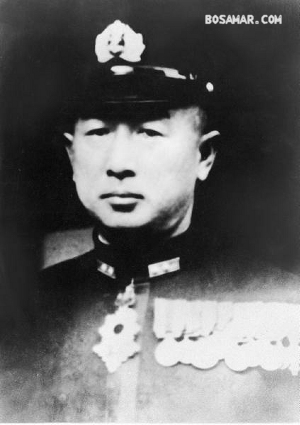 |
|||||||||
|
National Archives Photograph Vice Admiral Shoji Nishimura, IJN |
||||||||||
|
||||||||||
The last leg of the Japanese pincher that was also planned to storm into Leyte Gulf was a cruiser-destroyer force led by VADM Kiyohide Shima. This force was designated as the Second Striking Force by the Japanese GHQ.
The firepower of Second Striking Force came from its two 8-inch gun heavy cruisers:
Light cruiser ABUKUMA, was a Pearl Harbor veteran.
Four supporting destroyers completed the force.
These ships had sailed from the Inland Sea earlier in the month and, on October 21, were located in Coron Bay on Mindoro Island. Vice Admiral Shima had not been included in the SHŌ-GO planning initially. Now, as a last-minute ploy, his forces were directed to "cooperate" with those of VADM Kurita’s. In addition, he was also directed to "cooperate" with VADM Nishimura's Striking Force "C." This poor, last minute planning by the Staff at General Headquarters in Tokyo only complicated matters. Not only did the plan suffer from poor organization, but a personal conflict also existed. |
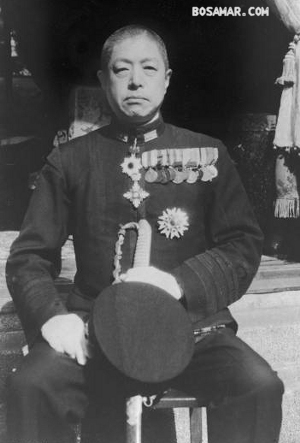 |
|||||||||
|
National Archive Photograph Vice Admiral Kiyohide Shima, IJN |
||||||||||
|
||||||||||
Vice Admiral Shima's six months' seniority to VADM Nishimura caused the latter much discontentment. The relationship between the two admirals was anything but cordial. Vice Admiral Shima was a political power within the fleet and had thus worked his way up through the rank structure. In contrast, VADM Nishimura was a salty "sailor’s admiral," gaining his flag rank through the command of sea-going ships and squadrons. As it turned out, due to their personal differences or stubborn pride, the coordination of their attack would be non-existent.
The General Headquarters staff's decision to attack during daylight did not sit favorably with VADM Kurita and his senior officers. They had trained for months for a night engagement, a tactic the Japanese Navy had developed a great proficiency in. They knew they stood no chance of victory during a daylight engagement with the Americans with their overwhelming superiority in carrier aircraft.
So great was their distaste for a daylight engagement, VADM Kurita felt a few words of encouragement were needed; here are his words:
"I know that many of you are strongly opposed to this assignment. But the war situation is far more critical than any of you can possibly know. Would it not be shameful to have the fleet remain intact while our nation perishes? I believe that the Imperial General Headquarters is giving us a glorious opportunity. Because I realize how very serious the war situation actually is, I am willing to accept even this ultimate assignment to storm into Leyte Gulf. You must all remember that there are such things as miracles. What man can say that there is no chance for our fleet to turn the tide of war in a decisive battle? We shall have a chance to meet our enemies. We shall engage his task forces. I hope that you will not carry your responsibilities lightly. I know that you will act faithfully and well."